

乡村性和乡村旅游吸引力:基于游客感知视角的要素结构辨识和认知机制解析
|
王铭杰(1998—),男,浙江温州人,硕士研究生,研究方向为区域规划与乡村旅游,(E-mail)306264432@qq.com; |
收稿日期: 2021-07-20
修回日期: 2021-09-06
网络出版日期: 2021-11-16
基金资助
国家自然科学基金(41901176)
海南省自然科学基金(418QN207)
海南省哲学社会科学规划课题 [HNSK (JD) 17-08]
Rurality and Rural Tourism Attraction: Element Structure Identification and Cognitive Mechanism Analysis Based on Tourists' Perception
Received date: 2021-07-20
Revised date: 2021-09-06
Online published: 2021-11-16
在旅游研究领域中,乡村性被普遍认为是乡村旅游的核心吸引力。然而,现有研究基本没有从游客感知视角对乡村性要素结构进行辨识,未能展现游客对乡村旅游吸引力的认知逻辑,也无法体现乡村性和乡村旅游吸引力之间的关系。因此,在游客感知视角下,使用VEP和半结构访谈相结合的质性研究方法,对受访者提供的乡村照片以及相对应的访谈内容进行编码归纳。研究发现:1)乡村性要素可依据游客视觉、听觉、触觉、味-嗅觉和定位系统构建乡村性结构,并可从中归纳出“本底乡村性”和“植入乡村性”两种类型。2)在乡村旅游的过程中,游客在个人主观层面存在“核心—边缘”结构的感知特征,其中“核心乡村性”和“边缘乡村性”两者之间界限模糊,且存在相互转换的可能。3)在游客感知视角下,乡村性和乡村旅游吸引力之间存在“感知系统—乡村性要素—乡村性景观—乡村旅游吸引力”为逻辑主线的认知机制,认为乡村旅游吸引力虽然可以以本底乡村性构成的本底性景观为基础,但同时也是一个复合的结构,由本底乡村性、植入乡村性组合而成的本底性、植入性和融合性景观综合构成,其中尤其不能忽略融合性景观对乡村旅游吸引力的营造作用。
王铭杰 , 孟凯 , 张世泽 , 李雯婕 , 唐佳欣 , 王辰露 . 乡村性和乡村旅游吸引力:基于游客感知视角的要素结构辨识和认知机制解析[J]. 热带地理, 2021 , 41(6) : 1325 -1337 . DOI: 10.13284/j.cnki.rddl.003407
With the development of the economy and the improvement in quality of life, the need for leisure tourism is increasing. Rural tourism, which can fulfil people's need to stay away from the city and pursue leisure, has been favored in recent years. From the perspective of tourists and the market, it is precisely owing to the unique characteristics of rural areas, formally called rurality, that people's psychological needs for rural tourism are met. Many scholars at home and abroad believe that rurality, which differs from the city lifestyle, and originated in the countryside, is the core attraction of rural tourism. However, most studies on rurality are concentrated in the field of geography, and relevant scholars have attempted to set up a scale to evaluate rurality or use social semiotics to interpret the connotation of rurality. However, extant research is still unable to identify the elements and structure of rurality from the perspective of tourists' perception, failing to show tourists' cognitive logic in the rural tourism experience or reflect the relationship between rurality and rural tourism attraction. To solve these problems, this study utilizes the qualitative research method combining visitor employed photography with semi-structured interviews, based on the five sensory perceptual systems proposed by Gibson (including the visual, auditory, tactile, taste-smell, and basic orienting systems). A total of 202 rural pictures and corresponding interview texts provided by 20 interviewees were coded to identify the elements and structure of rurality and illustrate the cognitive mechanism of rural tourism attraction from the perspective of tourists' perception. The main conclusions are summarized as follows. (1) First, as per tourists' perception, the rurality structure contains 234 elements and 42 categories, and further summarized into two core dimensions: basic rurality and implanted rurality. (2) Second, in the process of rural tourism, tourists rank rurality elements according to their attractiveness intensity, showing the "core-marginal" perception characteristic of their personal subjective level. Notably, the boundary between core rurality and marginal rurality is blurred, and the possibility of mutual conversion exists. (3) Third, the cognitive mechanism of rural tourism attraction from the perspective of tourists' perception follows the logical development of "Perceptual system—Rurality elements—Rurality landscape—Rural tourism attraction." Under the guidance of these logical clues, the study finds that although rural tourism attraction can be based on a basic landscape, it is also a composite structure, composed of basic, implanted, and integrative landscapes. The core attraction is mostly exerted by the integrative landscape. Overall, the study reveals the elements and structure of rurality from the perspective of tourists' perceptions in the tourism context and analyzes the cognitive mechanism of rural tourism attraction. The research expands and enriches the study of rurality, especially in the field of tourism. Moreover, it plays a guiding role in the development of rural tourism destinations and suggests that rural tourism developers take active steps to create integrative landscapes for tourists.
表1 Gibson感知系统理论模型Table 1 Gibson's theory model of perceptual system |
| 系统名称 | 感知方式 | 感知器官 | 感知来源 |
|---|---|---|---|
| 视觉系统 | 视觉 | 眼部机构 | 环境光的变化 |
| 听觉系统 | 听觉 | 耳蜗器官 | 空气中的震动 |
| 触觉系统 | 触觉 | 皮肤、关节、肌肉 | 组织形变、关节确认、肌纤维 |
| 味-嗅觉系统 | 味觉、嗅觉 | 口腔、鼻腔 | 介质组成 |
| 基本定位系统 | 身体信息 | 大脑前庭器官 | 重力和加速度 |
表2 受访者的基本情况Table 2 Basic information of interviewees |
| 序号 | 性别 | 年龄/岁 | 职业 | 受教育程度 | 照片数量/张 |
|---|---|---|---|---|---|
| P1 | 男 | 22 | 学生 | 硕士 | 22 |
| P2 | 女 | 24 | 公务员 | 本科 | 26 |
| P3 | 女 | 24 | 公司职员 | 专科及以下 | 10 |
| P4 | 女 | 48 | 经商 | 本科 | 8 |
| P5 | 男 | 74 | 退休 | 专科及以下 | 11 |
| P6 | 男 | 27 | 公司职员 | 本科 | 7 |
| P7 | 男 | 33 | 工人 | 专科及以下 | 6 |
| P8 | 女 | 14 | 学生 | 专科及以下 | 7 |
| P9 | 女 | 46 | 教师 | 本科 | 7 |
| P10 | 男 | 20 | 学生 | 专科及以下 | 8 |
| P11 | 女 | 42 | 公司职员 | 硕士 | 18 |
| P12 | 女 | 26 | 公司职员 | 本科 | 17 |
| P13 | 女 | 23 | 待业 | 本科 | 12 |
| P14 | 男 | 38 | 公司职员 | 专科及以下 | 7 |
| P15 | 女 | 25 | 教师 | 本科 | 6 |
| P16 | 女 | 69 | 退休 | 专科及以下 | 7 |
| P17 | 女 | 26 | 公司职员 | 专科及以下 | 5 |
| P18 | 女 | 24 | 公司职员 | 本科 | 6 |
| P19 | 男 | 25 | 学生 | 硕士 | 6 |
| P20 | 男 | 52 | 经商 | 专科及以下 | 6 |
表3 要素提炼的部分结果Table 3 Partial results of elements extraction |
| 图片示例 | 受访者 | 访谈描述内容 | 要素概念 | 感官来源 |
|---|---|---|---|---|
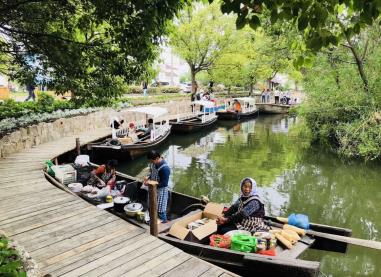 | P1 | “在乡村里的小溪旁有一些村民撑着船在岸边卖一些自家种植的瓜果蔬菜。这些瓜果蔬菜普遍价格便宜,而且比起城市里买到的更加新鲜爽口,也更加绿色、安全无污染,许多周边城市过来的游客会在周末节假日慕名而来,买好多回家屯着慢慢吃。路过他们附近时,这些船上的村民还会不停向我们介绍自己家的这些蔬菜,这样的场面令我感受到乡村农家无比的淳朴和热情。” | 蔬菜 原生态食品 吆喝 淳朴民风 | 视觉系统 味-嗅觉系统 听觉系统 触觉系统 |
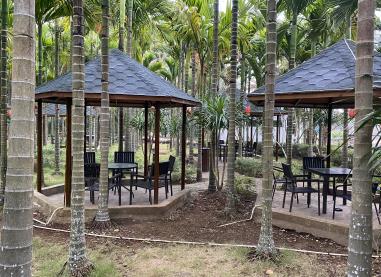 | P2 | “亭子在树林中间,让我不禁想到在炎热的夏天,要是能够与几个朋友一起坐在树荫下的亭子里喝喝茶,吹吹凉风,感受微风掠过面庞的轻柔触感和地上泥土的清香,那会是多么美好的画面。对我而言,在这样的自然环境中喝茶比起在城市的茶室让我觉得更加私密隐蔽,更加放松逍遥。” | 景观亭 喝茶 风吹簌簌 微风拂面 泥土芬芳 | 视觉系统 视觉系统 听觉系统 触觉系统 味-嗅觉系统 |
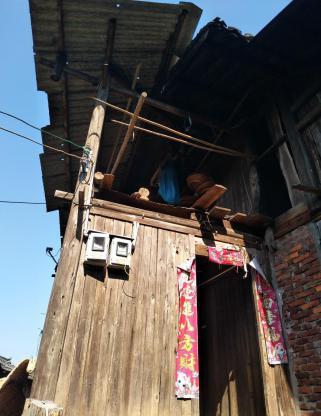 | P5 | “破旧的木屋门口贴着一副已经被太阳晒褪色、晒起角的对联,摸上去能明显感觉到木头和纸张常年经受风吹日晒所积累出的粗糙感。进屋后,一股冷飕飕的气息扑面而来,夹杂着一股木头潮湿的霉味。这栋木质老房子让我想起了自家的老宅,只可惜后来被认定成危房拆迁了,真是非常可惜。” | 房屋外观 装饰贴画 触摸建筑 幽闭老宅 木头霉味 | 视觉系统 视觉系统 触觉系统 定位系统 味-嗅觉系统 |
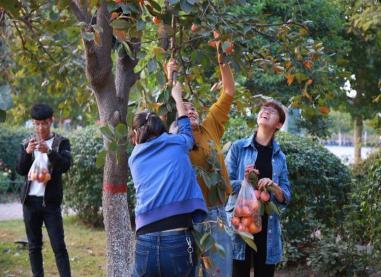 | P9 | “远远便看到了许多柿子挂在树梢,走近了还能闻到淡淡的香气,我们都忍不住去摘了好多。这些树上的柿子虽然不是自己种的,但总觉得是自己亲自去摘下来的,吃起来会更加放心!” | 水果 果香 果蔬采摘 吃得放心 | 视觉系统 味-嗅觉系统 触觉系统 触觉系统 |
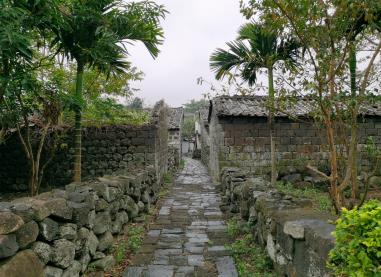 | P13 | “灰色的石头与两旁的绿植搭配和谐,身处其中能感觉到岁月静好的舒适缓慢。由火山石搭建的房屋和院墙在两边整齐紧凑地排列,共同营造出中间这条狭窄悠长的石头小路。这条小路一眼望不到头,颇有几分神秘的色彩,顿时激发我去一探究竟的欲望。” | 色彩组合 建筑用材 狭长小路 | 视觉系统 视觉系统 定位系统 |
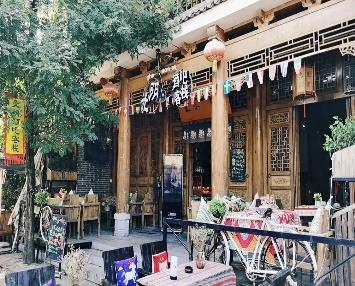 | P17 | “入住的民宿是网红树屋的造型,拍照非常好看。民宿里有乒乓球桌、KTV包厢、温泉、无边泳池和图书角,项目很丰富。最关键的是这旁边的酒吧街真是太热闹了,夜晚灯火通明,听着驻唱歌手唱歌,和朋友在这喝上两杯聊聊人生,很有感觉。” | 网红民宿 住宿配套 酒吧街 歌手唱歌 喝酒 | 视觉系统 触觉系统 视觉系统 听觉系统 味-嗅觉系统 |
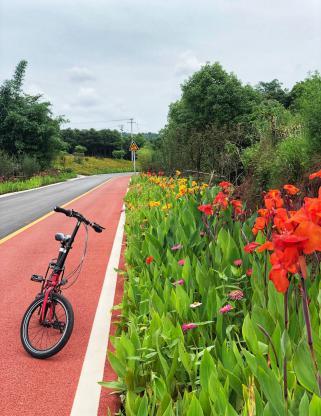 | P20 | “来到乡村的田野小路里散步,发现旁边有一条精致的游步道,道路两侧的景观林布置的姹紫嫣红,再配合上乡间新鲜的空气,让我觉得顿时神清气爽、心旷神怡。在这样的自然景色下,让我这个不太锻炼的人都有了想跑跑步的冲动。” | 步道 景观林 清新空气 跑步 | 视觉系统 视觉系统 味-嗅觉系统 触觉系统 |
|
表4 范畴归纳结果Table 4 Results of category induction |
| 范畴 | 要素概念(举例) | 感官来源 |
|---|---|---|
| 洁净的山水单体 | 河、湖、海、沙、小溪、池塘、水库、山岳…… | 视觉 系统 |
| 美丽的乡村自然全貌 | 山水景观、特殊形状、色彩组合…… | |
| 开阔的田园风光(大视域) | 树林、草原、农田、菜园、果园、庄园、花海…… | |
| 原生态的动植物(小视域) | 树木单体、水果、蔬菜、奇花异草、家养畜牧、野生动物…… | |
| 稀缺的水文和天气景观(大视域) | 彩虹、星空、雪景、雾凇、云海、潮汐…… | |
| 自然的天气景观产物(小视域) | 露珠、水汽、薄雾、雨、雪、云朵…… | |
| 地方传统的建筑和聚落形式 | 建筑用材、房屋构成元素、房屋外观、传统历史建筑、院落样式、院落空间元素、整村布局…… | |
| 地方传统的生产要素和场景 | 农具、庄稼、劳作、传统生产技艺、生产设备…… | |
| 地方日常化的生活要素和场景 | 村民、做饭、晾晒、买卖、喝茶、淘洗…… | |
| 地方遗址遗迹和历史人事 | 古窑、古战场、纪念碑、村落历史、古今人物…… | |
| 地方特色化的传统民俗和节庆 | 传统服饰、传统歌舞、民间习俗、比赛竞技…… | |
| 乡村传统物件和基础设施 | 装饰贴画、煤油灯、放映机、水井、水缸、石桥、船只、渡口、乡间道路…… | |
| 自然和农业资源改造景观 | 景观林、人造花海、艺术农田…… | |
| 新建建筑和体验场所 | 景观亭、博物馆、史料馆、产业园、研究所、游乐场、滑雪场、网红民宿、酒吧街、网红打卡地…… | |
| 城市化的生活设施 | 马路、路灯、交通驿站、公共厕所、垃圾回收站…… | |
| 乡村旅游衍生物和配套设施 | 展板、栈道、步道、观景台、缆车、房车、体验项目、文创商品、商业街到、景区…… | |
| 现代植入节庆活动 | 艺术展览、主题巡演、外来节庆…… | |
| 舒缓纯净的自然声 | 泉水叮咚、流水潺潺、海浪拍打、树叶沙沙、风吹簌簌、踩雪咯吱、自然寂静…… | 听觉 系统 |
| 欢快的动物声 | 虫鸣声、鸟叫声、家养畜牧声、野生动物声…… | |
| 农村原真的生活声 | 木门声、爆竹声、炒菜声…… | |
| 质朴的村民日常活动声 | 吆喝、本地方言、村民唠嗑…… | |
| 地方传统的乐器声和歌声 | 传统乐器、民乐、民歌…… | |
| 现代活动项目声 | 拉练口号、广播音乐、现代歌曲、歌手唱歌…… | |
| 游客进入乡村声 | 马达轰隆、游客唱歌、游客聊天…… | |
| 舒适的气候 | 避暑、多风、清凉、湿润…… | 触觉 系统 |
| 乡土环境中的触碰 | 触碰植物、抚摸动物、触摸建筑、微风拂面…… | |
| 慢节奏的栖居 | 烟火气息、生活节奏、自然原真…… | |
| 闲适舒缓的运动 | 爬山、徒步、溯溪、跑步、垂钓、骑车…… | |
| 地方原生活动参与体验 | 打牌、划船、果蔬采摘、文娱活动…… | |
| 乡村特有文化感知 | 价格实惠、吃得放心、热情好客、淳朴民风、文化积淀…… | |
| 现代运动形式 | 滑板、滑草、滑雪、滑翔伞、射箭、露营、攀岩…… | |
| 新奇的新建设施触感 | 体验辅助设施、新型建筑材料…… | |
| 乡村游玩项目体验 | 陶艺、卡丁车、漂流、研学、户外拓展、真人CS、住宿配套…… | |
| 城市生活气息 | 小资情调、商业气息、城市氛围…… | |
| 原生植物的芳香气息 | 草香、花香、果香、木香…… | 味-嗅觉 系统 |
| 乡间自然的气息 | 清新空气、泥土芬芳、木头霉味…… | |
| 农家烹饪的香气 | 锅气、饭菜香气、烧烤炭火气…… | |
| 传统乡村美味佳肴 | 农家家常菜、原生态食品、传统名小吃…… | |
| 高品质现代美食饮品 | 酒吧喝酒、咖啡厅饮食、主题餐厅品尝…… | |
| 特定的时间感 | 怀念过去、联想未来…… | 定位 系统 |
| 特殊的空间感 | 高大山峦、环绕群山、无垠田野、开阔视野、狭长小路、幽闭老宅…… | |
| 乡野的方位感 | 位于山林、远离城市、乡村全貌…… |

|
Bell D. 2000. Farm Boys and Wild Men: Rurality, Masculinity and Homosexuality. Rural Sociology, (65): 547-561.
|
|
Bell M M. 1994. Childerley: Nature and Morality in a Country Village. Chicago: University of Chicago Press.
|
|
Bramwell B and Lane B. 1994. Rural Tourism and Sustainable Rural Development. UK: Channel View Publications.
|
|
Browne W P. 2001. Rural Failure: the Linkage between Policy and Lobbies. Policy Studies Journal, (29): 108-117.
|
|
Bruinsma J. 2003. World Agriculture: towards an FAO Perspective. London: Earthscan.
|
|
Bunce M. 2003. Reproducing Rural Idylls in Country Visions. Harlow, UK: Pearson.
|
|
蔡运龙. 2001. 中国农村转型与耕地保护机制. 地理科学,21(1):1-6. [Cai Yunlong. 2001. The Mechanisms of Cropland Conservation in Chinese Rural Transformation. Scientia Geographica Sinic, 21(1): 1-6. ]
|
|
陈佳,张丽琼,杨新军,李纲. 2017. 乡村旅游开发对农户生计和社区旅游效应的影响——旅游开发模式视角的案例实证. 地理研究,36(9):1709-1724. [Chen Jia, Zhang Liqiong, Yang Xinjun and Li Gang. 2017. The Impact of Tourism Development on Changes of Households' Livelihood and Community Tourism Effect: A Case Study Based on the Perspective of Tourism Development Mode. Geographical Research, 36(9): 1709-1724. ]
|
|
池静,崔凤军. 2006. 乡村旅游地发展过程中的“公地悲剧”研究——以杭州梅家坞、龙坞茶村、山沟沟景区为例. 旅游学刊,21(7):17-23. [Chi Jing and Cui Fengjun. 2006. A Study on "The Tragedy of the Commons" in the Process of the Development of On-Limits Rural Tourism Destinations—A Case of Meijiawu, Longwu and Shangougou in Hangzhou. Tourism Tribune, 21(7): 17-23. ]
|
|
陈阳,李伟芳,马仁锋,李加林,任丽燕. 2014. 浙江省乡村性空间分异及其影响因素分析. 经济地理,34(12):133-139. [Chen Yang, Li Weifang, Ma Renfeng, Li Jialin and Ren Liyan. 2014. Spatio-Temporal Dynamics of Rurality and Influence Factors in ZheJiang Province. Economic Geography, 34(12): 133-139. ]
|
|
Chow K. 2009. Body, Senses & Architecture: Carving a Volume into the World of Darkness. Delft: Delft University of Technology.
|
|
Cloke P and Edwards G. 1986. Rurality in England and Wales 1981: a Replication of the 1971 Index. Journal of Rural Studies, (20): 289-306.
|
|
Cloke P and Milbourne P. 1992. Deprivation and Lifestyles in Rural Wales: Rurality and the Cultural Dimension. Journal of Rural Studies, (8): 359-371.
|
|
Edwards M B and David M C. 2011. Rurality in Leisure Research: A Review of Four Major Journals. Journal of Leisure Research, 43(4): 447-474.
|
|
范学刚,朱竑. 2016. 西方乡村性研究进展. 热带地理,36(3):503-512. [Fan Xuegang and Zhu Hong. 2016. Progress in Western Rurality Research in China. Tropical Geography, 36(3): 503-512. ]
|
|
冯淑华,沙润. 2007. 乡村旅游的乡村性测评模型——以江西婺源为例. 地理研究,26(3):616-624. [Feng Shuhua and Sha Run. 2007. Evaluation Model of Countryside Tourism's Rural Feature: A Case Study of Wuyuan in Jiangxi Province. Geographical Research, 26(3): 616-624. ]
|
|
Gibson J J. 1966. The Senses Considered as Perceptual Systems. London: George Allen&Unwin, 142.
|
|
Gray I and Lwarence G. 2001. A Future for Regional Australia. Cambridge: Cambridge University Press, 82.
|
|
郭鲁芳. 2005. 休闲经济学——休闲消费的经济分析. 杭州:浙江大学出版社,138. [Guo Lufang. 2005. Leisure Economics-Economic Analysis of Leisure Consumption. Hangzhou: Zhejiang University Press, 138. ]
|
|
Halfacree K.1993. Locality and Social Representation: Space, Discourse and Alternative Definitions of the Rural. Journal of Rural Studies, 9(1): 23-37.
|
|
Halfacree K. 1996. Out of Place in the Countryside: Travelers and the “Rural Idyll”. Antipode, (29): 42-71.
|
|
Harrington V and Dan O' Donoghue. 1998. Rurality in England and Wales: A Replication and Extension of the Rurality Index. Sociologia Ruralis, 38(2): 178-203.
|
|
何景明,李立华. 2002. 关于“乡村旅游”概念的探讨. 西南师范大学学报(人文社会科学版),28(5):125-128. [He Jingming and Li Lihua. 2002. A Study on the Conceptions of Rural Tourism. Journal of Southwest China Normal University (Humanities and Social Sciences Edition), 28(5): 125-128. ]
|
|
何景明. 2003. 国外乡村旅游研究述评. 旅游学刊,18(1):76-80. [He Jingming. 2003. A Study on Rural Tourism Overseas. Tourism Tribune, 18(1): 76-80. ]
|
|
Held D. 1999. Global Transformations: Politics, Economics and Culture. Cambridge, UK: Polity Press, 58.
|
|
Hoggart K and Buller H. 1995. Geographical Differences in British Property Acquisitions in Rural France. Geographical Journal, 161(1): 69-78.
|
|
Hoggart K and Paniagua A. 2001. What Rural Restructuring?. Journal of Rural Studies, 17(1): 41-62.
|
|
侯兵,黄震方,徐海军. 2010. 乡村旅游地的城市化效应及调控对策——基于旅游影响的分析视角. 商业经济与管理,227(9):71-78. [Hou Bing, Huang Zhenfang and Xu Haijun. 2010. The Effect of Rural Sightseeing Region Urbanization: Based on the Influence of Tourism. Journal of Business Economics, 227(9): 71-78. ]
|
|
金利霞,文志敏,范建红,杜志威. 2020. 乡村空间重构的理论研究进展与理论框架构建. 热带地理,40(5):765-774. [Jin Lixia, Wen Zhimin, Fan Jianhong and Du Zhiwei. 2020. Rural Spatial Restructuring: Theoretical Research Progress and Framework Construction. Tropical Geography, 40 (5): 765-774. ]
|
|
Lanfant M F. 1995. International Tourism: Identity and Change. London: Sage, 127.
|
|
李红波,张小林. 2015. 乡村性研究综述与展望. 人文地理,30(1):16-20,142. [Li Hongbo and Zhang Xiaolin. 2015. A Review and Trend on Rurality. Human Geography, 30 (1): 16-20, 142. ]
|
|
梁中雅,冯艳芬. 2016. 广东省乡村类型划分及乡村性评价的时空变化. 热带地理,36(6):995-1004. [Liang Zhongya and Feng Yanfen. 2016. Rural Development Types and the Spatio-Temporal Changes of Rurality in Guangdong Province. Tropical Geography, 36(6): 995-1004. ]
|
|
林峰. 2013. 旅游引导的新型城镇化. 北京:中国旅游出版社,66. [Lin Feng. 2013. New Urbanization Guided by Tourism. Beijing: China Tourism Press, 66. ]
|
|
Little J and Austin P. 1996. Women and the Rural Idyll. Journal of Rural Studies, 12: 101-111.
|
|
刘德谦. 2006. 关于乡村旅游、农业旅游与民俗旅游的几点辨析. 旅游学刊,21(3):12-19. [Liu Deqian. 2006. Several Discriminations in Rural Tourism, Agriculture Tourism and Folklore Tourism. Tourism Tribune, 21(3): 12-19. ]
|
|
刘沛林,于海波. 2012. 旅游开发中的古村落乡村性传承评价——以北京市门头沟区爨底下村为例. 地理科学,32(11):1304-1310. [Liu Peilin and Yu Haibo. 2012. Study on the AHP Model of Rurality Inheritance in the Ancient Village of Tourism Development: A Case Study of Chuandixia Village, Mentougou District, Beijing. Scientia Geographica Sinica, 32(11): 1304-1310. ]
|
|
刘沛林. 2015. 新型城镇化建设中“留住乡愁”的理论与实践探索. 地理研究,34(7):1205-1212. [Liu Peilin. 2015. The Theory and Practice Exploration of ''Remembering Nostalgia'' in the Construction of New Urbanization. Geographical Research, 34(7): 1205-1212. ].
|
|
刘彦随. 2007. 中国东部沿海地区乡村转型发展与新农村建设. 地理学报,62(6):563-570. [Liu Yansui. 2007. Rural Transformation Development and New Countryside Construction in Eastern Coastal Area of China. Acta Geographica Sinica, 62(6): 563-570. ]
|
|
龙花楼,刘彦随,邹健. 2009. 中国东部沿海地区乡村发展类型及其乡村性评价. 地理学报,64(4):426-434. [Long Hualou, Liu Yansui and Zou Jian. 2009. Assessment of Rural Development Types and Their Rurality in Eastern Coastal China. Acta Geographica Sinica, 64 (4): 426-434. ]
|
|
龙花楼. 2012. 中国乡村转型发展与土地利用. 北京:科学出版社,193. [Long Hualou. 2012. China's Rural Transformation and Land Use. Beijing: Science Press, 193. ]
|
|
楼嘉军,徐爱萍. 2009. 试论休闲时代发展阶段及特点. 旅游科学,23(1):61-66. [Lou Jiajun and Xu Aiping. 2009. On Stages and Features of the Development of the Leisure Era. Tourism Science, 23(1): 61-66. ]
|
|
陆林,任以胜,朱道才,程久苗,杨兴柱,杨钊,姚国荣. 2019. 乡村旅游引导乡村振兴的研究框架与展望. 地理研究,38(1):102-118. [Lu Lin, Ren Yisheng, Zhu Daocai, Cheng Jiumiao, Yang Xingzhu, Yang Zhao and Yao Guorong. 2019. The Research Framework and Prospect of Rural Revitalization Led by Rural Tourism. Geographical Research, 38 (1): 102-118. ]
|
|
吕祖宜,林耿. 2017. 混杂性:关于乡村性的再认识. 地理研究,36(10):1873-1885. [Lv Zuyi and Lin Geng. 2017. Hybridity: Rethinking Rurality. Geographical Research, 36(10): 1873-1885. ]
|
|
孟凯. 2016. 旅游发展引导下乡村城市化的驱动力——以云台山景区内乡村为例.热带地理,36(5):786-794,877. [Meng Kai. 2016. Driving Forces of Rural Urbanization Led by Tourism Development: A Case Study of the Villages in Yuntai Mountain. Tropical Geography, 36(5): 786-794, 877. ]
|
|
孟欢欢,李同昇,于正松,李飞. 2013. 安徽省乡村发展类型及乡村性空间分异研究. 经济地理,33(4):144-148,185. [Meng Huanhuan, Li Tongsheng, Yu Zhengsong and Li Fei. 2013. Rurality and a Spatial Correlation Analysis of the County Economy in Anhui Province. Economic Geography, 33 (4): 144-148, 185. ]
|
|
Mormont M. 1990. Who is Rural? Or, How to be Rural: Towards a Sociology of the Rural, Rural Restructuring: Global Process and Their Responses. London: David Fulton, 134.
|
|
Nelson K S, Nguyen T D and Brownstein N A. 2021. Definitions, Measures, and Uses of Rurality: A Systematic Review of the Empirical and Quantitative Literature. Journal of Rural Studies, 82(1): 351-365.
|
|
Pan S and Ryan C. 2009. Tourism Sense-Making: The Role of the Senses and Travel Journalism. Journal of Travel & Tourism Marketing, 26(7): 625-639.
|
|
Pfeiffer C, Serino A and Blanke O. 2014. The Vestibular System: a Spatial Reference for Bodily Self-Consciousness. Frontiers in Integrative Neuroscience, 8: 31.
|
|
Philo C. 1992. Neglected Rural Geographies: A Review. Journal of Rural Studies, 8(2): 193-207.
|
|
Short J R. 1991. Imagined Country. London: Routledge, 90.
|
|
孔艺丹,黄子璇,陶卓民,刘琪. 2019. 基于乡村性感知的游客环境责任行为影响机制研究——以南京市江宁区为例. 南京师大学报(自然科学版),42(1):124-131. [Su Yidan, Huang Zixuan, Tao Zhuomin and Liu Qi. 2019. Study on the Influence Mechanism of Tourists' Environmentally Responsible Behavior Based on Perception of Rurality — A Case Study of Jiangning District of Nanjing City. Journal of Nanjing Normal University (Natural Science Edition), 42(1): 124-131. ]
|
|
孙玉,程叶青,张平宇. 2015. 东北地区乡村性评价及时空分异. 地理研究,34(10):1864-1874. [Sun Yu, Cheng Yeqing and Zhang Pingyu. 2015. Spatio-Temporal Dynamics of Rurality in Northeast China. Geographical Research, 34(10): 1864-1874. ]
|
|
陶玉霞. 2015. 乡村旅游需求机制与诉求异化实证研究. 旅游学刊,30(7):37-48. [Tao Yuxia. 2015. An Empirical Study of the Demand Mechanism and Appeals-Alienation of Rural Tourism. Tourism Tribune, 30(7): 37-48. ]
|
|
Urry J. 1990. The Tourist Gaze: Leisure and Travel in Contemporary Societies. London: Sage, 74.
|
|
魏鸿雁,陶卓民,潘坤友. 2014. 基于乡村性感知的乡村旅游地游客忠诚度研究——以南京石塘人家为例.农业技术经济,(3):108-116. [Wei Yanhong, Tao Zhuomin and Pan Kunyou. 2014. Research on Tourist Loyalty of Rural Tourism Destination Based on Rurality—A Case Study of Shitang Family in Nanjing. Journal of Agrotechnical Economics, (3): 108-116. ]
|
|
Woods M. 2005. Rural Geography: Processes, Responses and Experiences in Rural Restructuring. London: Sage, 279-290.
|
|
吴丽娟,李洪波. 2010. 乡村旅游目的地乡村性非使用价值评估——以福建永春北溪村为例. 地理科学进展,29(12):1606-1612. [Wu Lijuan and Li Hongbo. 2010. Evaluation of the Non-Use Value of the Rurality of Rural Tourism Destinations: A Case Study of Beixi Village in Yongchun, Fujian Province. Progress in Geography, 29(12): 1606-1612. ]
|
|
谢翠玲,陈秋华,苏玉卿,肖婷婷. 2015. 五感视角下的乡村创意旅游产品开发研究——以棋磐寨采桑园为例. 林业经济问题,35(1):63-67,74. [Xie Cuiling, Chen Qiuhua, Su Yuqing and Xiao Tingting. 2015. A Study on the Exploitation of Rural Creative Tourism Product by Using the Perspective of Five Senses—A Case Study of Qipan Stockaded Village Mulberry Field. Issues of Forestry Economics, 35(1): 63-67, 74. ]
|
|
解芳芳,孙洁,刘风豹. 2020. 社区营造进程中的乡村地方性建构特征与机制——以台湾中和社区为例. 热带地理,40(6):1039-1050. [Xie Fangfang, Sun Jie and Liu Fengbao. 2020. Characteristics and Mechanism of Rural Placeness Construction in the Process of Community Empowerment: A Case Study of the Zhonghe Rural Community, Taizhong City. Tropical Geography, 40 (6): 1039-1050. ]
|
|
谢彦君,于佳,王丹平,陈枫. 2021. 作为景观的乡愁:旅游体验中的乡愁意象及其表征. 旅游科学,35(1):1-22. [Xie Yanjun, Yu Jia, Wang Danping and Chen Feng. 2021. Nostalgia as a Landscape:The Nostalgic Image and Its Representation in Tourist Experiences. Tourism Science, 35(1): 1-22. ]
|
|
徐洪. 2015. 旅游地乡村性感知量表的构建与实证研究. 绥化学院学报, 35(2):5-8. [Xu Hong. 2015. Construction and Empirical Research of Tourist Destination Rurality Scale. Journal of Suihua University, 35(2): 5-8. ]
|
|
尤海涛,马波,陈磊. 2012. 乡村旅游的本质回归:乡村性的认知与保护. 中国人口·资源与环境,22(9):158-162. [You Haitao, Ma Bo and Chen Lei. Essence Exploration of Rural Tourism: Rurality Cognizance and Protection. China Population, Resources and Environment, 22 (9): 158-162. ]
|
|
张机. 2015. 民族乡村旅游中文化展演的传统性与商业化冲突. 西北农林科技大学学报(社会科学版),15(6):130-136. [Zhan Ji. 2015. Cultural Conflicts Between Tradition and Commercialization on Performance Stage in Ethnic Rural Tourism. Journal of NWSTUAF (Social Science Edition), 15(6): 130-136. ]
|
|
张小林. 1998. 乡村概念辨析. 地理学报,53(4):365-371. [Zhang Xiaolin. 1998. On Discrimination of Rural Definitions. Acta Geographica Sinica, 53(4): 365-371. ]
|
/
| 〈 |
|
〉 |